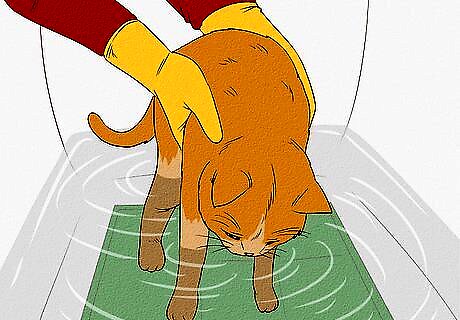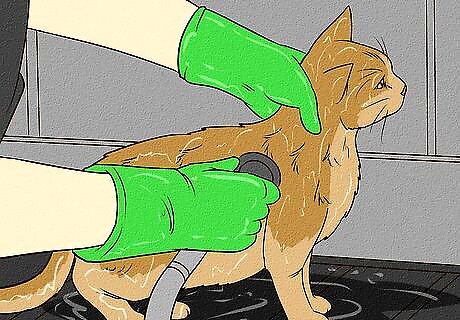
views
- When bathing a cat, massage cat shampoo into their coat from the neck down. Use a washcloth for their face and head.
- Play with your cat beforehand so they’re tired out and less likely to resist a bath.
- If your cat is extremely scared, stressed, or trying to fight, stop immediately. A bath isn’t worth either of you getting hurt.
Preparing to Bathe Your Cat

Desensitize your cat to water. If your cat isn’t used to being wet, don’t jump right into giving it a bath. Instead, slowly allow them to get comfortable with water over the course of days or weeks. Try dribbling water over their body or using a damp cloth on their legs. If your cat seems uncomfortable, stop and try again later so you don’t stress them out. If your cat has never been in the bathroom before, get them used to the area by allowing them to explore. Try letting the water run in the tub or sink so they get used to the sound.

Trim your cat’s claws. Your cat may become excited or scared when covered in water, so to decrease the damage they may cause, trim their nails before you give them a bath. Try to do this a few hours of even a day or two before the bath so they have time to calm down. Take care to cut at a point that won’t cause pain or bleeding. Give your kitty treats as a reward for getting their nails trimmed. This will help them feel calmer.

Brush your cat. Do not skip this step. Brushing the cat helps remove any knots or tangles in the fur, which will be more difficult and painful to remove once your cat is wet. If your kitty likes getting brushed, it might make them feel more at ease in the tub. Sometimes, brushing your cat can distract them enough to allow you to trim their nails. This is a great way to kill two birds with one stone, but you’ll need another person to help you. It’s also a good idea to brush your cat’s teeth before a bath so you can clean up any leftover toothpaste residue.

Tire your cat out before bathing. Play with your cat so they’re at their most mellow before they enter the water. This will help stop them from biting and scratching or trying to get away. Choose a time when they’re already calm, like after you feed them. Here are some other ways to get your kitty adjusted to the bath: Put some cat toys in the empty tub and allow your cat to play for a few minutes. Then, stop and add a little water before playing again. This allows your cat to get used to the tub and the water and helps them associate bath time with something pleasant and non-threatening. Pick out a special toy just for bath time, like a mouse on a string or something that floats. Only allow your cat to play with this toy in the tub to encourage them to look forward to bathing instead of fearing it.

Set up the tub. Lay down a rubber mat or towel in the tub so your kitty doesn’t slip. Fill the tub with a few inches of warm—not hot—water and fill 2 large cups or, ideally, plant watering pots, which allow you to direct the flow of water as you rinse the cat. This way, you don’t need to run more water during the bath, which might frighten your cat. Since some cats are unnerved by running water, it's a good idea to fill the tub before bringing them into the bathroom. Cats don’t sweat like humans do, so hot water can cause them to overheat. Make sure the water is a degree or two above lukewarm at most. Put towels on the floor, and have at least two towels on hand for drying your kitty. Make sure you have all the supplies you need within arms reach before you start the bath. To give the cat something to hold on to, place a small cooling rack or oven rack in the tub. This also reduces the chances of you being scratched. For a small cat or kitten, use a sink or smaller tub that you place in the bathtub. Or, if your cat doesn’t mind the shower, use a hand-held spray shower set to a gentle stream.

Wear protective clothing. This will keep you safe from any possible scratches, major or minor. Opt for a sweater or long-sleeved shirt so your cat has no bare skin to scratch. Wear jeans or thick pants to protect your legs. You can wear long-sleeved rubber gloves, as well, but these are bulky and can get in the way. Be careful and gentle when you rub your cat’s head and belly, as these are sensitive areas. It’s also a good idea to wear old clothing that you don’t mind getting wet.
Bathing Your Cat

Talk to your cat in a calm, quiet voice as you put them in the tub. Try to soothe your cat and hold them still so they don’t escape. Watch for signs of panic and distress like hissing, growling, breathing hard, crying, and meowing. If at any point your cat is too frightened, stop. There's no reason to continue if one or both of you will get hurt or stressed. If your cat prefers to have only two feet in the water, face them toward the back of the tub and let them stand on two feet while doing you hold them still. Consider using a well-fitting harness to safely hold your cat in the bathtub. Be easy on your cat for their first bath. Don’t do anything to make them dread the next bath. Take things slowly so you can try again next time. A scared 10-pound cat can do a lot of damage, so don't try to fight them. You may need to start with just getting their feet and legs wet and then stop. Try more another day and work your way up to a full bath. Keep the bathroom door closed and the toilet lid down during the bath.

Soak your cat and massage cat shampoo into its coat. Starting at the neck, pour a little water over your cat’s body and lather in the shampoo. Follow the growth of their fur toward the tail. Be sure to pay special attention to their “armpits” and genitals. Avoid the face and ears and only wash your cat’s neck, body, legs, belly, and tail. Buy cat shampoo. Check the instructions and dilute it with water, if needed. Human shampoo or dog shampoo can be toxic to cats and dry out their skin. Pet your cat throughout the bathing process to help soothe them and offer them treats as encouragement. To minimize the risk of an ear infection, put a cotton ball in each ear. The cotton may also reduce noise that can scare your cat. If you're giving your cat a flea bath, wet the area around its neck first. Fleas will try to escape to the dry areas, which could lead to a mass exodus of fleas to the head and face while you’re bathing. A wet neck will keep them off the head and in contact with the water and flea shampoo.

Rinse the shampoo thoroughly from your cat's fur. Use the water in the tub to thoroughly rinse your kitty. Then, drain the tub and rinse 2 more times with water from the bucket or warm water from the tap. It is essential that you remove all the soap from the coat. Keep rinsing until the water is completely clear and shows no sign of bubbles or soap. If your cat has dry skin or a long coat, you might want to apply a cat-safe conditioner after rinsing out the shampoo. Be sure you rinse the conditioner thoroughly, as well. Alternatively, wash and rinse your cat in 2 buckets: one for washing and one for rinsing. Apply the shampoo in the first, then dip your cat in the second to rinse the soap off.

Wash your kitty’s face with damp washcloth. There’s no need to take the risk of upsetting and hurting your cat by getting shampoo or soap in their eyes. Take a wet washcloth and gently run it along their face, brushing the fur away from their eyes and nose, until their head, face, and ears are nice and clean. You can also use a grooming wipe to clean their face and an ear cleaner for their ears. Just be sure to follow all directions carefully. If the bath was unsuccessful or particularly stressful to your cat, consider leaving this step for another time. Never force a cat’s face underwater. This is guaranteed to make them panic.

Blot your cat's fur with a fluffy towel to dry it off. Take a towel and gently press as much water as you can from the fur, as if you’re massaging your cat. Then, wrap your cat in the towel and rub gently. When the towel gets too wet to be effective, switch to another dry towel. If they won’t allow you to keep drying with the towels, respect that and stop. Give your cat a heat source, like a space heater or warm air vent, and a dry towel to sit on to finish drying themselves. Consider warming the towels in the dryer first, as many cats find this comforting. If your cat is not scared of a hair dryer, you can use one on a low, cool setting to finish drying them from a distance. Avoid using other heat settings since those can easily burn them. With long-haired cats, you need a comb and more towels. Long hairs mat more easily when wet, so you might want to comb the coat until it's completely dry.

Reward your cat with a treat. This is a must. If you want your cat to ever want to take a bath again, you must give them a positive association with the process. Give them their favorite wet food, catnip, or other treats. Give them an even more indulgent treat that you save for exceptionally rare occasions. If they associate bathing with receiving delicious treats, your cat will be clamoring for another go in the bathtub in no time at all. Be sure to praise your cat by petting them, telling them what a good kitty they are, and giving them lots of attention when the bath is over. They’re likely to feel vulnerable and scared if they don’t feel loved, so your affection will make a big difference.
Alternatives to Bathing

Wipe your cat down with a wet washcloth. This removes the outer dirt and cleans well. You can find pet wipes at pet stores that need no water to groom the cat. They even have a pleasant scent.

Use dry cat shampoo. If your cat hates water, opt for a rinse-free cat shampoo. Look for a natural, unscented, hypoallergenic option and follow the product’s instructions to apply it to your cat.

Rub your cat with cornstarch. If your cat is very oily, consider using cornstarch instead of water to bathe them. Dust your cat with the cornstarch and gently pet them to rub it into their fur. Let the cornstarch sit for about 20 minutes and then brush it out. This technique is far less traumatic than using water but should not be used to wash off anything poisonous that your cat has gotten onto their fur.

Take your cat to the groomer or vet. If all else fails, take your cat to a reputable, professional pet groomer or a veterinary hospital for grooming. They have experience and equipment to keep the cat calm and safely restrained. Some cats may require sedation if the veterinarian feels drugs are safe and appropriate.
When to Bathe a Cat

Most cats rarely, if ever, need you to bathe them. Cats do a great job of keeping themselves clean, and since water is a foreign substance on their coat, it often feels dirty to them. However, there are some instances when you might need to give your cat a bath, like if they’re sick or injured. Other common reasons: Mobility issues: senior cats (8+ years old) often develop arthritis, joint pain, or other issues that limit their mobility, and they may need your help if they can’t reach certain parts of their body. You need to clean off something toxic: since cats bathe by licking themselves, you should bathe them if they get into any chemicals or oils that would harm them like paint, motor oil, or antifreeze. Seek veterinary help, as well, as these chemicals are extremely harmful. They have feces stuck to them: sometimes, feces may get stuck in your cat’s fur. Try to remove it with a pet wipe first, but if that doesn’t work, you might need to bathe them. Matted fur: if your cat’s fur has painful mats, it might be time to give them a bath. This is especially true for long-haired breeds. Avoid this by brushing their coat daily. They’re lethargic: if your cat is older or has medical issues, they may lack the energy to properly bathe themselves and need your assistance. They’re injured: your veterinarian may recommend bathing an injured cat as part of wound care. Be sure to follow their instructions carefully, and only bathe the cat at a vet’s recommendation. Skin conditions: if your cat has allergies, fleas, ringworm, or other skin conditions, a medicated bath might soothe their skin and provide treatment. Consult your vet before bathing and follow their instructions carefully. Being overweight: if a cat is very overweight, they may struggle to reach certain parts of their body. In this case, they may need help to properly clean themselves. If they’re a hairless Sphynx: Sphynx cats have genetic conditions that cause them to produce an excess of skin oil, so routine bathing (once every 1 to 2 weeks) helps reduce skin infections. Apart from emergencies, only bathe your cat once or twice a year, if at all, and never more than once every 1 or 2 months. Always consult your vet before giving your cat a bath. Baths can alter your cat’s natural scent, which is important for recognition. Smelling different will not only stress your cat out, but it might cause non-recognition aggression between cats if you own more than one. Only bathe your cat when it’s absolutely necessary.


















Comments
0 comment